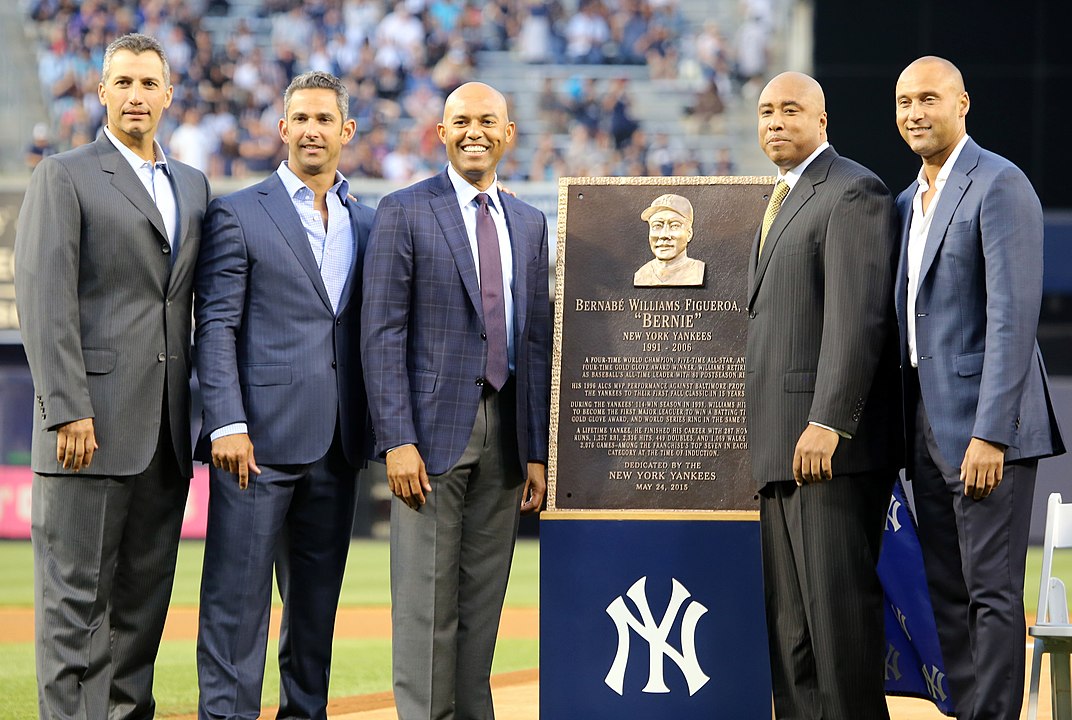THIS DAY IN BÉISBOL May 24: Bernie Williams becomes a Yankee immortal

By Robert Dominguez
No team sells tradition and history like the New York Yankees. But true fans know that whenever mention is made of the beloved and now fabled “Core Four” — the group of elite, homegrown players that formed the nucleus of the Bombers’ late-1990s dynasty and was still together for the 2009 championship run — there’s one vital player from the era who gets short shrift.
On this day in béisbol, May 24, 2015, the Yankees gave Bernie Williams the ultimate honor. In front of a packed house at The Stadium, the organization retired his No. 51 and presented him with a plaque honoring his myriad of achievements to be hung alongside the team’s other immortals in Monument Park behind centerfield.
Williams was fittingly joined by his Core Four teammates on this day: Derek Jeter and Mariano Rivera, now both Hall of Famers, and Andy Pettitte and Jorge Posada, likewise great Yankees who have deservedly also had their numbers retired.
Yet even on this day, it felt like Williams was being treated like Pete Best at a Beatles reunion. As his teammates posed with him for photos on the field, it was like the Core Four plus One —- a totally unfair designation that belittles Williams’ place in team, history.
Without the graceful Williams playing a Gold Glove-caliber centerfield, batting in the cleanup spot — as a switch-hitter, no less — and coming up just as big in post-season clutch situations as Jeter often did, there’s no four World Series rings in 1996 and 1998 to 2000 for the Yankees, no overall AL East dominance that mostly dovetailed with Williams’ 16 years in pinstripes from 1991 to 2006.
A native of Puerto Rico who also happens to be a Grammy-winning jazz guitarist, Williams was the first homegrown position player since Don Mattingly came up in the early 1980s to have a career worthy of Yankee immortality.
Jeter, in fact, has said that if it wasn’t for the soft-spoken Williams developing into an excellent player that proved it was worth taking a shot on the kids down on the farm, the 1990s Yankees under George Steinbrenner’s volatile ownership would have likely been a frustrating repeat of the 1980s — good young players being traded away for veterans past their prime.
Including some, if not all, of the Core Four.
So in defense of Williams — who happens to rank in the top six or seven lifetime in most of the Yankees’ major offensive categories behind only the Mount Rushmore likes of Ruth, Gehrig, DiMaggio, Berra, Mantle and Jeter — the reason it’s the Core Four and not, say, the Fab Five, is actually a technicality.
He wasn’t around in 2009.
That’s the year the Yankees, on the strength of their fat wallet, won the World Series after shopping for starters CC Sabathia and A.J. Burnett and first baseman Mark Teixeira in the free agent market (after earlier handing Alex Rodriguez a ridiculous 10-year contract that would take him into his forties).
Well, here’s another technicality to put Williams’ omission from the exclusive four-man club into perspective. Posada, who like his other Core Four brethren all made their MLB debuts in 1995, was the late bloomer of the bunch. In 1996, when the Yanks won their first World Series since 1978 to kick off their latest dynasty, the catcher was a late-season call-up who appeared in only eight games — and had a whopping total of one hit to show for a season in which he received a championship ring.
In other words, he was Ringo Starr just as the band was getting big.
Long live the Fab Five.
Robert Dominguez is co-author of “Bronx Bummers: The Unofficial History of the New York Yankees’ Bad Boys, Blunders and Brawls” and writer of the upcoming “El Salón: The Trials and Triumphs of Baseball’s Latino Hall of Famers.”
Photo: Arturo Pardavila III, Under Creative Commons License, public domain




